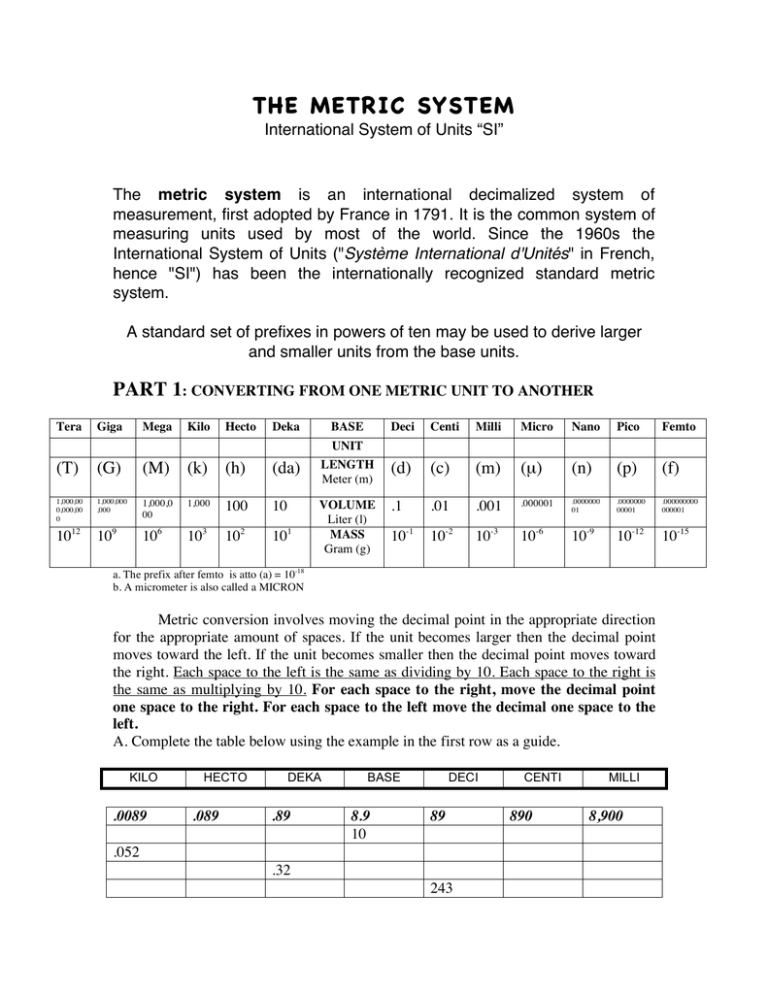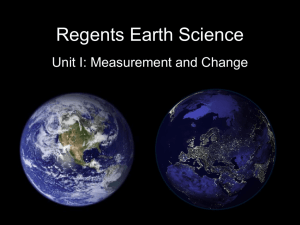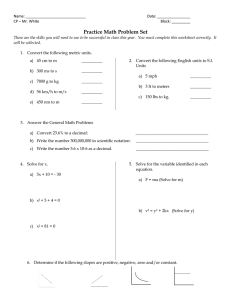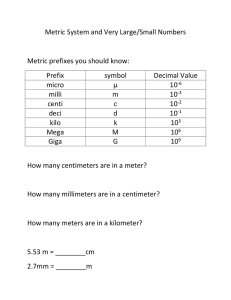part 1: converting from one metric unit
advertisement

THE METRIC SYSTEM International System of Units “SI” The metric system is an international decimalized system of measurement, first adopted by France in 1791. It is the common system of measuring units used by most of the world. Since the 1960s the International System of Units ("Système International d'Unités" in French, hence "SI") has been the internationally recognized standard metric system. A standard set of prefixes in powers of ten may be used to derive larger and smaller units from the base units. PART 1: CONVERTING FROM ONE METRIC UNIT TO ANOTHER Tera Giga Mega Kilo Hecto Deka BASE Deci Centi Milli Micro Nano Pico Femto UNIT (T) (G) (M) (k) (h) (da) LENGTH Meter (m) (d) (c) (m) (µ) (n) (p) (f) 1,000,00 0,000,00 0 1,000,000 ,000 1,000,0 00 1,000 100 10 .1 .01 .001 .000001 .0000000 01 .0000000 00001 .000000000 000001 1012 109 106 103 102 101 VOLUME Liter (l) MASS Gram (g) 10-1 10-2 10-3 10-6 10-9 10-12 10-15 a. The prefix after femto is atto (a) = 10-18 b. A micrometer is also called a MICRON Metric conversion involves moving the decimal point in the appropriate direction for the appropriate amount of spaces. If the unit becomes larger then the decimal point moves toward the left. If the unit becomes smaller then the decimal point moves toward the right. Each space to the left is the same as dividing by 10. Each space to the right is the same as multiplying by 10. For each space to the right, move the decimal point one space to the right. For each space to the left move the decimal one space to the left. A. Complete the table below using the example in the first row as a guide. KILO .0089 HECTO .089 DEKA .89 BASE 8.9 10 DECI 89 .052 .32 243 CENTI 890 MILLI 8,900 10,500 .012 3.67 29.6 108 B. Convert the following units. Simply write down the SAME number and move the decimal the appropriate amount of spaces. 1m = 1dm = 1cm = 1dm = 1cm = 1m = 1m = 1dm = 1mm = 1cm = 6.45dm = 8.45dm = 86.5dm = 46cm = 793cm = 950g= dm cm mm m m cm mm mm m dm mm cm m dm m kg 68.4mm= 9.42m = 56.4dm = 64mm = 68m = 42.5dm= 5.63m= 79.43cm= 543mm= 52cm= 35ml = 275mm= 1,000L= 1,000ml= 4,500mg= 25cm = m dm mm m cm mm mm m m dm dl cm kl l g mm .005kg = .075m = 15g = 3mm = 43cm = 2.5km = .5cm = .006g = 2.5 dL = 350mL = 750mL = 39.2mg = 12 m = 12 dL = 1.2daL = 32dam = dag cm mg cm dm dam dam cg L daL L kg km kL mL dam PART 2: Match the correct metric unit to each object or organism listed below. Write your answer on the line next to the number. a. b. c. d. 1. 2. 3. 4. 5. 6. 7. 8. 9. 10. 11. Centimeter degrees Celsius gram kilogram e. kilometers per hour f. liter g. meter h. micron height of a tree mass of a hamster volume of an aquarium length of a small insect mass of an insect volume of a graduated cylinder temperature of a classroom length of a microscopic organism mass of an elephant speed of an automobile length of a test tube 12. 13. 14. 15. 16. 17. 18. 19. 20. 21. 22. i. milligram j. milliliter k. millimeter l. kilometers volume of 2-liter soda bottle length of horse mass of a student temperature of a river length of a football field mass of a watermelon mass of a sunflower seed distance from San Jose to L.A. length of a whale length of a goldfish mass of a dime PART 3: Refer to the information in the following chart as you answer the questions below. 1 meter = 100 centimeters = 1000 millimeters = 1,000,000 microns 1 liter = 1,000 milliliters = 1,000 cubic centimeters 1 kilogram = 1,000 grams 1 gram = 1,000 milligrams 1. How many millimeters in one meter ? 2. How many millimeters in one centimeter? 3. A line 5 cm long is how many millimeters long ? 4. A lab table is 2 meters long. What is it’s length in millimeters ? 5. A lab table is 2 meters long. What is it’s length in centimeters ? 6. A microscope’s mass is 1 kilograms. What is it’s mass in grams ? 7. Three liters of water contain how many milliliters ? 8. Circle the largest measurement in each pair below. a. 2 m or 50 cm b. 11 cm or 15mm c. 1m or 120 cm d. 5 cm or 60 mm e. 100 mg or 50 cg f. 32 cl or 321ml g. 1000mg or 2g h. 53ml or 53 cl i. 126cg or 200mg j. 101dag or 1 kg PART 4: Refer to the 9 lines next to the questions as you answer the following questions. 1. What is the length of line a in cm ? in mm? 2. What is the length of line b in cm ? in mm? 3. What is the length of line c in cm ? in mm? 4. What is the length of line d in cm ? in mm? 5. What is the length of line e in cm ? in mm? 6. What is the length of line f in cm ? in mm? 7. What is the length of line g in cm ? in mm? 8. What is the length of line h in cm ? in mm? 9. What is the length of line i in cm ? in mm? Line a Line b Line c Line d Line e Line f Line g Line h Line i PART 5: SCIENTIFIC NOTATION Scientists very often deal with very large and very small numbers, which can lead to a lot of confusion when counting zeros! Instead of using all these zeros we can express very large or very small numbers as POWERS OF 10. Scientific notation takes the form of Mx10n where M ≥ 1 and M < 10. n represents the number of decimal places to be moved. Positive n indicates that the standard form is larger than zero, whereas negative n would indicate a number smaller than zero. Example 1: Convert 1,500,000 to scientific notation (number greater than zero) Move the decimal point so that there is only one digit to it’s left, a total of 6 places. 1,500,000 = 1.5 x 106 Example 2: Convert 0.00025 to scientific notation (number less than zero) Move the decimal point so that there is only one digit to it’s left of the whole number,. In this case a total of 4 places to the right. When the number is less than zero the exponent is ALWAYS negative. 0.00025 = 2.5 x 10-4 Convert the following to scientific notation: 1) .005 = 4) .0008 = 7) 1,000,000 = 10) .025 = 13) 500 = 2) 5,050 = 5) 1,000 = 8) .25 = 11) .0025 = 14) 5,000 = 3) 4,567 = 6) .0092 = 9) .0001 = 12) 18.65 = 15) 4,000 = Convert the following to standard notation: 1) 1.5 x 103 = 3) 3.75 x 10-2 = 5) 2.2 x 105 = 7) 3.32 x 101 = 9) 1.2 x 104 = 11) 7.5 x 103 = 13) 1.56 x 102 = 15) 3.5 x 106 = 17) 8.5 x 100 = 2) 1.5 x 10-3 = 4) 3.75 x 102 = 6) 2.2 x 10-5 = 8) 3.32 x 10-1 = 10) 1.2 x 10-4 = 12) 7.5 x 10-3 = 14) 1.56 x 10-2 = 16) 3.5 x 10-6 = 18) 1.5 x 100 = PART 6: ESTIMATES AND MEASUREMENTS You will be shown a meter stick. Based on this you will estimate the length of various objects around the room in cm. You will remain in your seat while making your estimates. You will next get up and measure, in cm, all of the objects you have estimated Next, you will calculate the difference between your estimate and measurement (estimate minus measurement). Finally, you will convert these measurements to km, mm and dm. OBJECT Length of textbook Width of textbook Width of whiteboard Length of whiteboard Width of window Width of a nickel Width of classroom door Height of classroom door Length of classroom front to back Height of classroom Length of a new pencil Height of coffee can Height of box Length of box Distance from this room to the next room Length of lab table Height of lab table Length of microscope slide Height of microscope slide ESTIMATE in cm, cl or cg MEASURE in cm, cl or cg DIFFERENCE (Estimate minus measurement) CONVERT To milli CONVERT to deci CONVERT to kilo Width of microscope slide Volume in graduated cylinder Volume of beaker B. Analysis 1. What is the metric unit used to measure length? 2. What metric unit is used to study volume? 3. Why is it easier to convert meters to centimeters rather than feet to inches? 4. Which mathematical process (multiply or divide) is used to convert the following? a. centiliters to liters? b. Centiliters to deciliters? c. Meters to centimeters? d. Millimeters to meters? PART 7: MEASURING BODY PARTS Introduction: The sizes and locations of adult human body parts are based on certain measurements and relationships. For example, your eyebrows are on the same level as the tops of your ears; the bottom of your ears line up with the base of your nose. There is a reason that your foot size is what it is. Your body parts are related to each other. Measure different body parts and compare them. 1. Make a measuring tape: Cut out the meter tape on the lasat page of this packet. Tape it together so that it forms a meter long ruler. When you finish this activity, save your ruler, you will use it again. 2. Whole body: Outstretch your arms to either side of your body. Measure the following: a. Distance from longest fingertip to longest fingertip. b. Measure your height. c. Distance from your chin to the top of your head. And multiply total by 7 d. Look at the measurements. If you measured carefully they should be about the same. Are they? 3. Half Body: Find the top of your thighbone by bending over and putting your hands just below your hips. Sway from side to side and you should feel the top of the thighbone stick out. Measure the following: a. Distance from the top of your head to the top of your thighbone. b. Distance from top of thighbone to the bottom of your foot. c. Look at the measurements. If you measured carefully they should be about the same. Are they? 4. Elbow: When your arm is straight down your side your elbow should be at the same level as your navel. Measure the following: a. The distance between your shoulder and your elbow. b. The distance between your elbow and wrist. c. Look at the measurements. If you measured carefully they should be about the same. Are they? 5. Foot: Measure the following: a. Distance around your closed fist b. Distance between wrist and elbow c. Inside of your foot from the very end of your heel to the Tip of your big toe. d. The measurements should be about the same. Are they?



